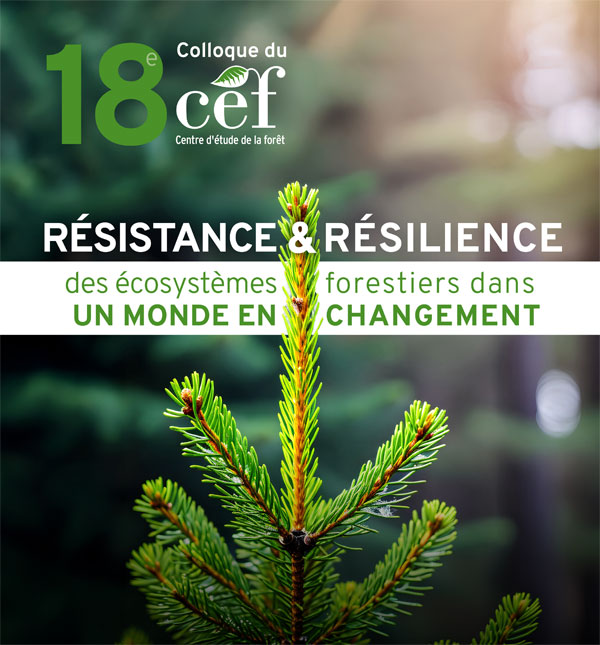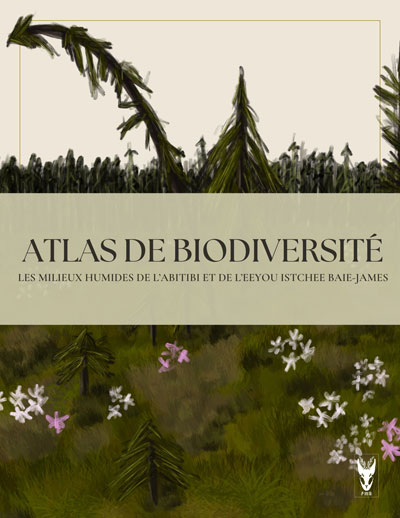(ré-aiguillé depuis Membres.TimWork)

Timothy Work
Membre régulier
Entomologie
Université du Québec à Montréal
Pavillon des sciences biologiques (SB-2890)
Département des sciences biologiques
141 Président-Kennedy
Montréal (Québec), Canada, H2X 3Y5
(514) 987-3000 Poste 2448
FORMATION
- Postdoctorat en biodiversité des insectes, University of Alberta
- Ph.D. en entomologie, 2000 (Oregon State University)
- M.Sc. en entomologie, 1996 (Michigan State University)
- B.Sc. en biologie, 1993 (Hope College)
THÈMES DE RECHERCHE
La conservation de la biodiversité dans les paysages forestiers sous aménagement
Ses recherches visent quantifier l’efficacité de la gestion forestière alternative vis-à-vis la conservation de la biodiversité. Les questions principales incluent « Quels sont les effets de la coupe partielle sur la biodiversité? » et « Comment les communautés d’insectes saproxyliques sont modifiés dans un paysage sous aménagement forestier? » Cette recherche fait la comparaison des communautés d’insectes entre les forêts boréale de l’ouest du Canada, au projet EMEND (Ecoystem Management Emulating Natural Disturbance - Alberta ![]() ) et à l’est, au projet SAFE (Sylviculture et Aménagement Forestier Ecosystémiques - Québec)
) et à l’est, au projet SAFE (Sylviculture et Aménagement Forestier Ecosystémiques - Québec) ![]() . Dans ce contexte, des communautés d’insectes sont utilisées comme indicateurs écologiques pour quantifier les effets du brûlage dirigé et de la coupe partielle.
. Dans ce contexte, des communautés d’insectes sont utilisées comme indicateurs écologiques pour quantifier les effets du brûlage dirigé et de la coupe partielle.
Interactions entre les insectes, les champignons et le bois mort
La relation entre la biodiversité et les fonctions écosystèmiques est devenue une justification pour l’importance de la conservation. En forêt boréale, des insectes et des champignons aident contrôler le flux des nutriments du bois mort vers le sol. Ce projet évalue les interactions entre deux groupes trophiques d'insectes, les prédateurs généralistes et les fongivores, les champignons décomposeur et la qualité et la connectivité de bois mort. Parmi les facteurs clés, l’importance de la dispersion des insectes dans les réseaux de bois morts et la capacité de propagation des champignons seront évalués. Ce projet vise aussi à évaluer des aspects de la biodiversité comme la rareté et ainsi que d'autres domaines de la macroécologie.
L’écologie des espèces envahissantes
Les espèces envahissantes qui arrivent via le commerce étranger causent le dommage extensif dans les forêts de l’Amérique Nord. Je fait partie d’un groupe de recherche qui est responsable de l’identification les pistes d’arrivée accidentelle d’espèces phytophage qui pose une risque pour les ressources forestiers. Ce travail fait avec la collaboration d’USDA-APHIS (Animal Plant Health Inspection Service) ![]() et le Centre d’Analyses et Synthèses Écologique (NCEAS)
et le Centre d’Analyses et Synthèses Écologique (NCEAS) ![]() . Nous développons les approches pour prévoir combien d’espèces actuellement arrivent via des taux élevés de la globalisation et quelles caractéristiques aident l’invasion favorable.
. Nous développons les approches pour prévoir combien d’espèces actuellement arrivent via des taux élevés de la globalisation et quelles caractéristiques aident l’invasion favorable.
DISTINCTIONS REÇUES
- 21 novembre 2008: Décoration Léon-Provancher, catégorie Jeune chercheur remis lors du congrès de la SEQ (Société d'entomologie du Québec)

Vous pouvez télécharger toutes mes références bibliographiques en format BibTeX, BibTeX-CSV, FRQNT ou EndNote
PUBLICATIONS
Livres
Aucun
Chapitres de livre
- Pappas, C., Belanger, N., Bergeron, Y., Blarquez, O., Chen, H.Y.H., Comeau, P.G., De Grandpre, L., Delagrange, S., DesRochers, A., Diochon, A. et al. (2022) Smartforests Canada: A Network of Monitoring Plots for Forest Management Under Environmental Change. In Climate-Smart Forestry in Mountain Regions. (Tognetti, Roberto, Smith, Melanie and Panzacchi, Pietro, Eds.) Cham, Springer International Publishing, pages 521-543
- Klimaszewski, J., Brunke, A.J., Work, T.T., Venier, L. (2018) Rove beetles (coleoptera, staphylinidae) as bioindicators of change in boreal forests and their biological control services in agroecosystems: Canadian case studies. In Biology of Rove Beetles (Staphylinidae). (Betz O., Irmler U., Klimaszewski J., Eds.) Springer, Cham, pages 161-181
- Kneeshaw, D.D., Sturtevant, B.R., Cooke, B., Work, T.T., Pureswaran, D., De Grandpre, L., MacLean, D. (2015) Insect Disturbances in Forest Ecosystems. (Chap. 7) In Routledge Handbook of Forest Ecology. (Peh, K.S.-H., Corlett, R.T. and Bergeron, Y., Eds.) Routledge, Oxford, UK
- Work, T.T., Spence, J.R., Volney, W.J.A., Burton, P.J. (2003) Sustainable forest management as license to think and to try something different. (Chap. 23) In Towards Sustainable Management of the Boreal Forest. (Burton, P.J., Messier, C., Smith, D.W. and Adamowicz, W.L., Eds.) NRC Research Press, pages 953-970
Livres, numéros spéciaux et actes de colloques publiés à titre d'éditeur
Aucun
Articles révisés par un comité de lecture
- Yataco, A.P., Noor, S., Montoro Girona, M., Work, T.T., Despland, E. (2024) Limited Differences in Insect Herbivory on Young White Spruce Growing in Small Open Plantations and under Natural Canopies in Boreal Mixed Forests. Insects, 15(3)
- Egli, L., Work, T.T. (2024) Forest harvest causes rapid changes of maternal investment strategies in ground beetles. Ecology, 105(7)
- Work, T.T., Morris, D.M., Loboda, S., Klimaszewski, J., Wainio-Keizer, K., Venier, L. (2023) Cumulative effects of biomass harvesting and herbicide application on litter-dwelling arthropod communities in jack pine-dominated forests: 7th year postharvest assessment. Canadian Journal of Forest Research, 53(11):931 – 952
- Noualhaguet, M., Work, T.T., Soubeyrand, M., Fenton, N.J. (2023) Bryophyte community responses 20 years after forest management in boreal mixedwood forest. Forest Ecology and Management, 531:120804
- Lee, S.-I., Langor, D.W., Spence, J.R., Pinzon, J., Pohl, G.R., Hartley, D.J., Work, T.T., Wu, L. (2023) Rapid recovery of boreal rove beetle (Staphylinidae) assemblages 16 years after variable retention harvest. Ecography, 2023:e06347
- Noualhaguet, M., Work, T.T., Soubeyrand, M., Fenton, N.J. (2023) Twenty-year recovery of managed stand, in structure and composition, in boreal mixedwood stands of northwestern Quebec. Canadian Journal of Forest Research, 53(7):478 – 490
- Venier, L., Morris, D., Work, T.T. (2023) Overview of the 2022 North American Forest Ecology Workshop (NAFEW): Turning Ecological Answers into Forest Management Actions. Canadian Journal of Forest Research, 53(11):820 – 822
- Liu, Z., Peng, C., De Grandpré, L., Candau, J.-N., Work, T.T., Zhou, X., Kneeshaw, D.D. (2020) Aerial spraying of bacterial insecticides to control spruce budworm defoliation leads to reduced carbon losses. Ecosphere, 11(1):e02988
- Egli, L., LeVan, K.E., Work, T.T. (2020) Taxonomic error rates affect interpretations of a national-scale ground beetle monitoring program at National Ecological Observatory Network. Ecosphere, 11(4)
- Ulyshen, M.D., Lucky, A., Work, T.T. (2020) Effects of prescribed fire and social insects on saproxylic beetles in a subtropical forest. Scientific Reports, 10(1):9630
- Liu, Z., Peng, C., De Grandpre, L., Candau, J.-N., Work, T.T., Huang, C., Kneeshaw, D.D. (2019) Simulation and Analysis of the Effect of a Spruce Budworm Outbreak on Carbon Dynamics in Boreal Forests of Quebec. Ecosystems, 22(8):1838-1851
- Boué, C., DeBellis, T., Venier, L.A., Work, T.T., Kembel, S.W. (2019) Limited initial impacts of biomass harvesting on composition of wood-inhabiting fungi within residual stumps. PeerJ, 2019(12)
- Liu, Z., Peng, C., Work, T.T., Candau, J.-N., DesRochers, A., Kneeshaw, D.D. (2018) Application of machine-learning methods in forest ecology: recent progress and future challenges. Environmental Reviews, 26(4):339-350
- Joelsson, K., Hj�ltén, J., Work, T.T. (2018) Uneven-aged silviculture can enhance within stand heterogeneity and beetle diversity. Journal of Environmental Management, 205:1 - 8
- {Joelsson, K., Hj�ltén, Work, T.T., Gibb, H., Roberge, J.-M., L� (2017) Uneven-aged silviculture can reduce negative effects of forest management on beetles. Forest Ecology and Management, 391:436 - 445
- Hoekman, D., LeVan, K.E., Ball, G.E., Browne, R.A.., Davidson, R.L.., Erwin, T.L., Knisley, C.B., LaBonte, J.R., Lundgren, J., Maddison, D.R. et al. (2017) Design for ground beetle abundance and diversity sampling within the National Ecological Observatory Network. Ecosphere, 8(4):e01744-n/a
- {Hj�ltén, J., Joelsson, K., Gibb, H., Work, T.T., L� (2017) Biodiversity benefits for saproxylic beetles with uneven-aged silviculture. Forest Ecology and Management, 402:37 - 50
- Venier, L., Work, T.T., Klimaszewski, J., Morris, D.M., Bowden, J.J., Kwiaton, M.M., Webster, K., Hazlett, P. (2017) Ground-dwelling arthropod response to fire and clearcutting in jack pine: implications for ecosystem management. Canadian Journal of Forest Research, 47(12):1614-1631
- Work, T.T., Andersson, J., Ranius, T., Hj�ltén, J. (2016) Defining stump harvesting retention targets required to maintain saproxylic beetle biodiversity. Forest Ecology and Management, 371:90 - 102
- Payette, M., Work, T.T., Drouin, P., Koubaa, A. (2015) Efficacy of microwave irradiation for phytosanitation of wood packing materials. Industrial Crops and Products, 69:187-196
- Doblas-Miranda, E., Work, T.T. (2015) Localized effects of coarse woody material on soil oribatid communities diminish over 700 years of stand development in black-spruce-feathermoss forests. Forests, 6(4):914-928
- Jacobs, J., Work, T.T., Pare, D., Bergeron, Y. (2015) Paludification of boreal soils reduces wood decomposition rates and increases wood-based carbon storage. Ecosphere
- Nock, C.A., Taugourdeau, O., Work, T.T., Messier, C., Kneeshaw, D.D. (2014) Urban forests on the front line. Science, 343(6168):249
- Work, T.T., Brais, S., Harvey, B.D. (2014) Reductions in downed deadwood from biomass harvesting alter composition of spiders and ground beetle assemblages in jack-pine forests of Western Quebec. Forest Ecology and Management, 321:19-28
- Doblas-Miranda, E., Paquette, A., Work, T.T. (2014) Intercropping trees' effect on soil oribatid diversity in agro-ecosystems. Agroforestry Systems, 88(4):671-678
- Deady, R., Heller, K., Work, T.T., Venier, L. (2014) Peyerimhoffia jaschhoforum (Diptera, Sciaridae), a new deadwood inhabiting species from Canada. Biodiversity Data Journal, 2(1)
- Brais, S., Work, T.T., Robert, E., OConnor, C., Strukelj, M., Bose, A.K., Celentano, D., Harvey, B.D. (2013) Ecosystem Responses to Partial Harvesting in Eastern Boreal Mixedwood Stands. Forests, 4(2):364-385
- Fenton, N.J., Imbeau, L., Work, T.T., Jacobs, J., Bescond, H., Drapeau, P., Bergeron, Y. (2013) Lessons learned from 12 years of ecological research on partial cuts in black spruce forests of northwestern Québec. Forestry Chronicle, 89(03):350-359
- Work, T.T., Klimaszewski, J., Thiffault, E., Bourdon, C., Pare, D., Bousquet, Y., Venier, L., Titus, B. (2013) Initial responses of rove and ground beetles (Coleoptera, Staphylinidae, Carabidae) to removal of logging residues following clearcut harvesting in the boreal forest of Quebec, Canada. ZooKeys, 258:31-52
- Graham-Sauve, L., Work, T.T., Kneeshaw, D.D., Messier, C. (2013) Shelterwood and multicohort management have similar initial effects on ground beetle assemblages in boreal forests. Forest Ecology and Management, 306:266-274
- Klimaszewski, J., Morency, M.-J., Labrie, P., Seguin, A., Langor, D., Work, T.T., Bourdon, C., Thiffault, E., Pare, D., Newton, A.F. et al. (2013) Molecular and microscopic analysis of the gut contents of abundant rove beetle species (Coleoptera, staphylinidae) in the boreal balsam fir forest of Quebec, Canada. ZooKeys, 353:1-24
- Gervais, D., Greene, D.F., Work, T.T. (2012) Causes of variation in wood-boring beetle damage in fire-killed black spruce (Picea mariana) forests in the central boreal forest of Quebec. Ecoscience, 19(4):398-403
- Jacobs, J.M., Work, T.T. (2012) Linking deadwood-associated beetles and fungi with wood decomposition rates in managed black spruce forests. Canadian Journal of Forest Research, 42(8):1477-1490
- Work, T.T., Hibbert, A. (2011) Estimating species loss of saproxylic insects under scenarios of reduced coarse woody material in eastern boreal forests. Ecosphere, 2(4):art41
- Paradis, S., Work, T.T. (2011) Partial cutting does not maintain spider assemblages within the observed range of natural variability in Eastern Canadian black spruce forests. Forest Ecology and Management, 262(11):2079-2093
- Work, T.T., St-Onge, B., Jacobs, J.M. (2011) Response of female beetles to LIDAR derived topographic variables in Eastern boreal mixedwood forests (Coleoptera, Carabidae). ZooKeys, 147:623-639
- Jacobs, J.M., Bergeron, C., Work, T.T., Spence, J.R. (2011) Low intensity surface fire instigates movement by adults of Calosoma frigidum (Coleoptera, Carabidae). ZooKeys, 147:641-649
- Work, T.T., Jacobs, J.M., Spence, J.R., Volney, W.J. (2010) High levels of green-tree retention are required to preserve ground beetle biodiversity in boreal mixedwood forests. Ecological Applications, 20(3):741-751
- Work, T.T., Koivula, M., Klimaszewski, J., Langor, D., Spence, J., Sweeney, J., Hebert, C. (2008) Evaluation of carabid beetles as indicators of forest change in Canada. Canadian Entomologist, 140(4):393-414
- Pohl, G., Langor, D., Klimaszewski, J., Work, T.T., Paquin, P. (2008) Rove beetles (Coleoptera : Staphylinidae) in northern Nearctic forests. Canadian Entomologist, 140(4):415-436
- Spence, J.R., Langor, D.W., Jacobs, J.M., Work, T.T., Volney, W.J.A. (2008) Conservation of forest-dwelling arthropod species: simultaneous management of many small and heterogeneous risks. Canadian Entomologist, 140(4):510-525
- Klimaszewski, J., Langor, D.W., Work, T.T., Hammond, J.H.E., Savard, K. (2008) Smaller and more numerous harvesting gaps emulate natural forest disturbances: a biodiversity test case using rove beetles (Coleoptera, Staphylinidae). Diversity and Distributions, 14(6):969-982
- Liebhold, A.M., Work, T.T., McCullough, D.G., Cavey, J.F. (2006) Airline Baggage as a Pathway for Alien Insect Species Invading the United States. American Entomologist, 53(1):48-54
- Klimaszewski, J., Pelletier, G., Germain, C., Work, T.T., Hebert, C. (2006) Review of Oxypoda species in Canada and Alaska (Coleoptera, Staphylinidae, Aleocharinae): Systematics, bionomics, and distribution. Canadian Entomologist, 138(6):737-852
- McCullough, D.G., Work, T.T., Cavey, J.F., Liebhold, A.M., Marshall, D. (2006) Interceptions of nonindigenous plant pests at US ports of entry and border crossings over a 17-year period. Biological Invasions, 8(4):611-630
- Klimaszewski, J., Langer, D.W., Work, T.T., Pelletier, G., Hammond, H.E.J., Germain, C. (2005) The effects of patch harvesting and site preparation on ground beetles (Coleoptera, Carabidae) in yellow birch dominated forests of southeastern Quebec. Canadian Journal of Forest Research, 35(11):2616-2628
- Work, T.T., McCullough, D.G., Cavey, J.F., Komsa, R. (2005) Arrival rate of nonindigenous insect species into the United States through foreign trade. Biological Invasions, 7(2):323-332
- Work, T.T., Shorthouse, D.P., Spence, J.R., Volney, W.J.A., Langor, D. (2004) Stand composition and structure of the boreal mixedwood and epigaeic arthropods of the Ecosystem Management Emulating Natural Disturbance (EMEND) landbase in northwestern Alberta. Canadian Journal of Forest Research, 34(2):417-430
- Larsen, K.J., Work, T.T. (2003) Differences in ground beetles (Coleoptera: Carabidae) of original and reconstructed tallgrass prairies in northeastern Iowa, USA, and impact of 3-year spring burn cycles. Journal of Insect Conservation, 7(3):153-166
- Marshall, D., Work, T.T., Cavey, J.F. (2003) Invasion pathways of Karnal bunt of wheat into the United States. Plant Disease, 87(8):999-1003
- Larsen, K.J., Work, T.T., Purrington, F.F. (2003) Habitat use patterns by ground beetles (Coleoptera: Carabidae) of northeastern Iowa. Pedobiologia, 47(3):288-299
- Work, T.T., Spence, J.R., Volney, W.J.A., Morgantini, L.E., Innes, J.L. (2003) Integrating biodiversity and forestry practices in western Canada. Forestry Chronicle, 79(5):906-916
- Work, T.T., McCullough, D.G. (2002) Lepidopteran community response to gypsy moth outbreaks is robust to guild reclassification: A reply to Summerville and Crist [2]. Environmental Entomology, 31(4):584-587
- Work, T.T., Buddle, C.M., Korinus, L.M., Spence, J.R. (2002) Pitfall trap size and capture of three taxa of litter-dwelling arthropods: Implications for biodiversity studies. Environmental Entomology, 31(3):438-448
- Work, T.T., McCullough, D.G. (2000) Lepidopteran communities in two forest ecosystems during the first gypsy moth outbreaks in Northern Michigan. Environmental Entomology, 29(5):884-900
- Lepczyk, C.A., Murray, K.G., Winnett-Murray, K., Bartell, P., Geyer, E., Work, T.T. (2000) Seasonal fruit preferences for lipids and sugars by American Robins. Auk, 117(3):709-717
- Progar, R.A., Schowalter, T.D., Work, T.T. (1999) Arboreal invertebrate responses to varying levels and patterns of green-tree retention in Northwestern Forests. Northwest Science, 73(SPEC. ISS.):77-86
Articles publiés dans des actes de colloque (proceedings)
- Jacobs, J., Work, T.T., Spence, J.R. (2008) Influences of succession and harvest intensity on ground beetle (Coleoptera:Carabidae) populations in the boreal mixedwood forests of Alberta, Canada: species matter. In Back to the Roots and Back to the Future? Towards a new synthesis between txonomic, ecological and biogeographical approaches in carabidology:. August. (Penev, L., Erwin, T. and Assmann, T., Eds.) Pensoft: Sophia-Moscow. Pages 425-450. Proceedings of the XIII European Carabidologists Meeting, Blagoevrgard
Rapports scientifiques, manuels et autres
- MacDonald, S.E., Lecompte, N., Bergeron, Y., Brais, S., Chen, H., Comeau, P., Drapeau, P., Liefers, V., Quideau, S., Spence, J. et al. (2010) Ecological implications of changing the composition of boreal mixedwood forests. A state of knowledge. Technical report, Sustainable forest management network
- Work, T.T. (2009) Responses of arthropod biodiversity to variable green-tree retention at the EMEND experiment. SFM Research Note. 43, SFMN, NSERC
Thèses, mémoires et essais
- Work, T.T. (2000) Edge effects of clearcut harvesting on ground arthropod species composition and predator community structure in old-growth Douglas-fir forests. Thèse de doctorat, Oregon State University
- Work, T.T. (1996) The impacts of gypsy moth (lepidoptera:lymantriidae) on native arthropod abundance, species richness, and diversity in two hardwood ecosystems in northern lower Michigan. Mémoire de maîtrise, Michigan State University
Thèses, mémoires et essais supervisés
- Deregowski, U. (2024) Response of saproxylic beetle communities twenty years after clearcut and partial cut harvests in the eastern boreal mixedwood forest. Mémoire de maîtrise, Université du Québec à Montréal
- Boucher, N. (2024) Conservation des guêpes parasitoïdes en sapinières vierges et impacts des coupes forestières sur leurs populations. Mémoire de maîtrise, Université du Québec à Montréal
- Boué, C. (2018) L'impact des récoltes de la biomasse forestière sur la composition et la diversité des champignons dans les souches résiduelles. Mémoire de maîtrise, Université du Québec à Montréal
- Payette, M. (2014) Freiner la propagation de ravageurs du bois par phytosanitation aux micro-ondes et identification d'envahisseurs potentiels par tests de préférence d'hôte. Mémoire de maîtrise, Université du Québec à Montréal
- Graham-Sauvé, L. (2012) Impacts des coupes partielles de la zone d'aménagement écosystémique du projet Triade sur les communautés de carabes (Coleoptera : Carabidae) en forêt boréale mixte de la Haute Mauricie. Mémoire de maîtrise, Université du Québec à Montréal
- Longpré, F. (2011) Les effets des coupes forestières sur la diète des coléoptères en forêt boréale mixte. Mémoire de maîtrise, Université du Québec à Montréal
- Hibbert, A. (2010) Importance of fallen coarse woody debris to the diversity of saproxylic diptera in the boreal mixedwood forests of eastern North America. Mémoire de maîtrise, UQAM
- Paradis, M. (2010) Évaluation de l'effet des coupes partielles sur les arthropodes terricoles dans des peuplements d'épinette noire sujets à la paludification. Mémoire de maîtrise, UQAM
- O'Connor, C. (2009) La réponse des communautés de Carabes à l'aménagement écosystémique dans la forêt boréale mixte de l'ouest du Québec. Mémoire de maîtrise, Université du Québec à Montréal
Articles non révisés par un comité de lecture
Aucun
<< Christian von Sperber | MembresReguliers | Dominique Arseneault >>










